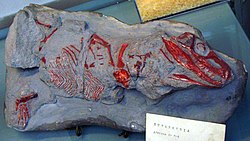Euparkeria
|
Euparkeria Temporal range: Middle Triassic |
|
|---|---|
 |
|
| Euparkeria cast, Muséum national d'Histoire naturelle, Paris | |
| Scientific classification | |
| Kingdom: | Animalia |
| Phylum: | Chordata |
| Class: | Reptilia |
| Family: | †Euparkeriidae |
| Genus: |
†Euparkeria Broom, 1913 |
| Type species | |
|
†Euparkeria capensis Broom, 1913 |
|
| Synonyms | |
|
|
Euparkeria (/juːˌpɑːrkəˈriːə/; meaning "Parker's good animal", named in honor of W.K. Parker) is an extinct genus of archosauriform from the Middle Triassic of South Africa. It was a small reptile that lived between 245-230 million years ago, and was close to the ancestry of Archosauria, the group that includes dinosaurs, pterosaurs, and modern birds and crocodilians. Euparkeria had hind limbs that were slightly longer than its forelimbs, which has been taken as evidence that it may have been able to rear up on its hind legs as a facultative biped. Although Euparkeria is close to the ancestry of fully bipedal archosaurs such as early dinosaurs, it probably developed bipedalism independently. Euparkeria was not as well adapted to bipedal locomotion as dinosaurs and its normal movement was probably more analogous to a crocodilian high walk.
The hind limbs of Euparkeria are somewhat longer than its forelimbs, which has led many researchers to conclude that it could have occasionally walked on its hind legs as a facultative biped. Other possible adaptations to bipedalism in Euparkeria include rows of osteoderms that could have stabilized the back and a long tail that could act as a counterbalance to the rest of the body. Paleontologist Rosalie Ewer suggested in 1965 that Euparkeria may have spent most of its time on four legs but moved on its hind legs while running. However, adaptations to bipedalism in Euparkeria are not as obvious as they are in some other Triassic archosauriforms such as dinosaurs and poposauroids; the forelimbs are still relatively long and the head is so large that the tail may not have effectively counterbalanced its weight. The position of muscle anchorage points on the humerus or thigh bones suggest that Euparkeria could not have held its legs in a fully erect posture beneath its body, but would have held them slightly out to the side as in modern crocodilians and most other quadrupedal Triassic archosauriforms. Euparkeria has a large backward-pointing projection on the calcaneum (an ankle bone) that would have given strong leverage to the ankle during locomotion. A calcaneal projection may have enabled Euparkeria to move with all four limbs in a semi-erect "high walk" similar to the way in which living crocodilians sometimes move about on land.
...
Wikipedia
